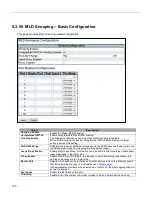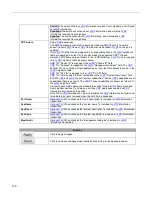
135
Landmark
Landmark or vanity address - Example: Columbia University.
Additional location info
Additional location info - Example: South Wing.
Name
Name (residence and office occupant) - Example: Flemming Jahn.
Zip code
Postal/zip code - Example: 2791.
Building
Building (structure) - Example: Low Library.
Apartment
Unit (Apartment, suite) - Example: Apt 42.
Floor
Floor - Example: 4.
Room no.
Room number - Example: 450F.
Place type
Place type - Example: Office.
Postal community name
Postal community name - Example: Leonia.
P.O. Box
Post office box (P.O. BOX) - Example: 12345.
Additional code
Additional code - Example: 1320300003.
Emergency Call Service
Emergency Call Service
Emergency Call Service
ELIN identifier data format is defined to carry the ELIN
identifier as used during emergency call setup to a traditional CAMA or ISDN
trunk-based PSAP. This format consists of a numerical digit string, corresponding to
the ELIN to be used for emergency calling.
Policies
Delete
Check to delete the policy. It will be deleted during the next save.
Policy ID
ID for the policy. This is auto generated and shall be used when selecting the policies
that shall be mapped to the specific ports.
Application Type
Intended use of the application types:
1.
Voice
- for use by dedicated IP Telephony handsets and other similar appliances
supporting interactive voice services. These devices are typically deployed on a
separate VLAN for ease of deployment and enhanced security by isolation from data
applications.
2.
Voice Signalling
(conditional) - for use in network topologies that require a
different policy for the voice signaling than for the voice media. This application type
should not be advertised if all the same network policies apply as those advertised in
the
Voice
application policy.
3.
Guest Voice
- support a separate 'limited feature-set' voice service for guest users
and visitors with their own IP Telephony handsets and other similar appliances
supporting interactive voice services.
4.
Guest Voice Signaling
(conditional) - for use in network topologies that require a
different policy for the guest voice signaling than for the guest voice media. This
application type should not be advertised if all the same network policies apply as
those advertised in the
Guest Voice
application policy.
5.
Softphone Voice
- for use by softphone applications on typical data centric
devices, such as PCs or laptops. This class of endpoints frequently does not support
multiple VLANs, if at all, and are typically configured to use an 'untagged' VLAN or a
single 'tagged' data specific VLAN. When a network policy is defined for use with an
'untagged' VLAN (see Tagged flag below), then the L2 priority field is ignored and only
the DSCP value has relevance.
6.
Video Conferencing
- for use by dedicated Video Conferencing equipment and
other similar appliances supporting real-time interactive video/audio services.
7.
Streaming
Video - for use by broadcast or multicast based video content
distribution and other similar applications supporting streaming video services that
require specific network policy treatment. Video applications relying on TCP with
buffering would not be an intended use of this application type.
Summary of Contents for RGS Series
Page 7: ...7 Preface Scope Audience Safety Instructions Documentation Conventions ...
Page 9: ...9 Overview Overview Faceplate Panel Introduction ...
Page 13: ...13 Quick Installation Equipment Mounting Cable Connecting Equipment Configuration ...
Page 18: ...18 Figure 6 RGS200 12P Series Ground Connections ...
Page 36: ...36 5 2 1 Configuration Menu ...
Page 37: ...37 5 2 2 Monitor Menu ...
Page 38: ...38 5 2 3 Diagnostics Menu 5 2 4 Maintenance Menu ...
Page 54: ...54 5 3 12 Privilege Level This page provides an overview of the privilege levels ...
Page 238: ...238 Click to re start diagnostics with PING ...
Page 252: ...252 台灣 警告使用者 ...
















































